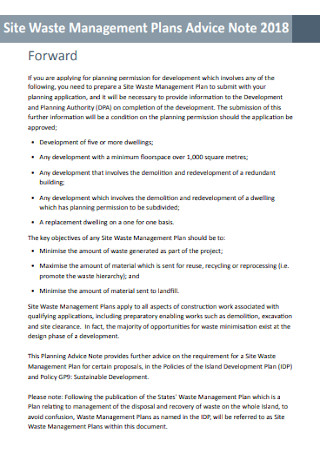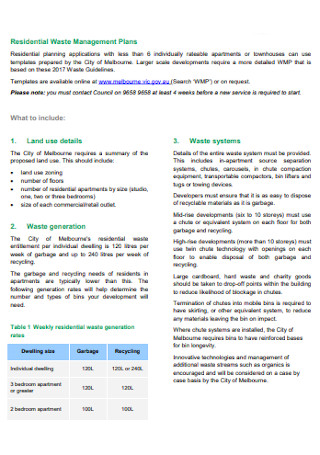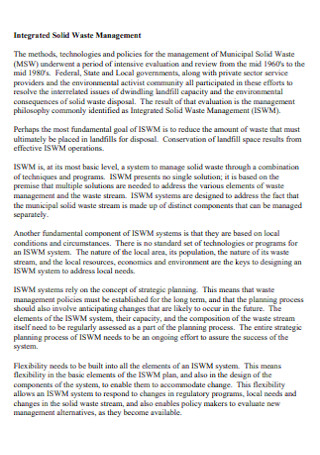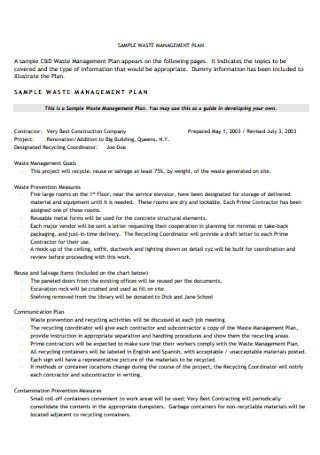42+ Sample Waste Management Plans
-

Scope Of Waste Management Plan Template
download now -

Free Simple Project Waste Management Plan Template
download now -

Waste Management Business Plan Template
download now -

Sample Waste Management Plan
download now -

Site Waste Management Plan
download now -

Waste Management Plan for Solar Park
download now -

Simple Waste Management Plans
download now -

Waste Management Plan for Smart Cities
download now -

Laboratory Waste Management Plan
download now -

Medical Weast Management Plan
download now -

Health Care Waste Management Plan
download now -

Construction Waste Management Plan
download now -

Residential Waste Management Plans
download now -

Integrated Solid Waste Management Plan
download now -

Trade Waste Management Plan
download now -

Operational Waste Management Plan
download now -

Oil Spill Waste Management Plan
download now -

Waste Management Plan Worksheet
download now -

Waste Management Plan for Municipal Corporation
download now -

Integrated Health Care Waste Management Plan
download now -

Consultation on Site Waste Management Plan
download now -

Outline Waste Management Plan
download now -

Basic Waste Management Plan
download now -

Integrated Waste Management Plan
download now -

Campus-Wide Waste Management Plan
download now -

Waste Management Reduction Plan
download now -

Waste Management Plan for University
download now -

Waste Management Plan Template
download now -

Sustainable Plastic Waste Management Plan
download now -

Sample Construction Waste Management Plan
download now -

Waste Management Structure Plan
download now -

City of Waste Management Plan
download now -

Sample Waste Management Plan Example
download now -

Company Waste Management Plan
download now -

Waste Management Plan Handout
download now -

Waste Management Action Plan
download now -

Waste Management Plan Format
download now -

Regional Waste Management Plans
download now -

Interim Waste Management Plan
download now -

Preliminary Site Waste Management Plan
download now -

10 Years Solid Waste Management Plan
download now -

Waste Management Plan Checklist
download now -

Cultivation Licensing Waste Management Plan
download now
FREE Waste Management Plan s to Download
42+ Sample Waste Management Plans
What Is a Waste Management Plan?
Five Types of Wastes
The Five R’s of Waste Management
How to Create an Effective Waste Management Plan
FAQs
What is the purpose of a waste management plan?
Are there disadvantages to waste management?
How do you help solve simple waste problems?
What Is a Waste Management Plan?
A waste management plan is a record that addresses the refuse of solid, liquid, and gas. It also includes both hazardous and non-hazardous waste materials that are the byproducts of organizational projects and processes. It lists the activities and actions to handle waste from the moment of its inception up until its final disposal. Factors like the collection, transport, treatment, and disposal of garbage materials, along with the monitoring and regulation of the waste management process following waste-related laws, technology, and economic mechanisms, must be present. Each organization presents a well-structured project management plan under government statutes and legislations.
According to the Facts and Figures about Materials, Waste, and Recycling made public by the United States Environmental Protection Agency (EPA), the total generation of municipal solid waste (MSW) in 2018 reaches 292.4 million tons. It amounts to 4.9 pounds of waste produced by a single person in the United States. While some trash can be recycled and composted, a staggering 50 percent or 156 million tons are in landfills.
Five Types of Wastes
It is essential to keep our environment clean, and having a waste management plan established that. Maintaining clear surroundings allows people to live healthy and comfortable. People, factories, processes, and animals contribute to waste production every day and are an unavoidable part of civilization. There are five classifications of wastes, and people and organizations must be aware of these.
The Five R’s of Waste Management
As people living in one ecosystem, it is our duty and responsibility to manage our wastes in a sustainable manner that influences the earth positively. It is helpful to remember the five R’s of waste management, namely, refuse, reduce, reuse, repurpose, and recycle, to do our responsibility in keeping our earth healthy. Incorporating this methodology into your business reduces waste and boosts recycling efforts.
How to Create an Effective Waste Management Plan
Many companies seek to find environmentally friendly solutions and interventions to cut down waste products and produce a sustainable way to market their products or services. Reaching those targets may pose to be a challenge to organizations, more often than not. To learn about achieving the road to streamlined and responsible waste management, follow these steps for a comprehensive and cost-effective way for your business.
Step 1: Create a Waste Management Goal Through Collaboration
Using a collaborative approach allows you to develop viable and self-supporting partnerships with the local and government agencies to assist in the cooperation of the recycling systems and solid waste management. It permits your company to increase negotiation between public and private sectors to achieve the best possible plan for improving recycling and waste management practices. At the same time, it helps with reducing the harmful effects of wastes on the environment. In creating a waste management goal, remember that there are two types that the company must consider. First is the company’s general intentions for waste management, and second is the necessary steps to achieve those intentions.
Step 2: Identify the Type and Volume of Waste Then Segregate It
It is vital to know the type of waste and the volume of waste that the company generates regularly. After doing so, segregate the different kinds of garbage into categories, whether they are recyclable or not. It also helps to separate wastes into hazardous materials and chemical compositions.
Step 3: Monitor Waste and Practice a Waste Reduction Program
Active monitoring of waste production helps to identify waste management requirements and look for ways to reduce the generation of waste materials. Introducing a waste reduction program is also necessary for any organization to improve communication and cooperation. It benefits to recognize a waste management coordinator within the company to create a program exhibiting company smart goals.
Step 4: Implement Proper Waste Collection
Ensure that the company’s bin containers are of correct sizes with a regular collection to avoid bad smells and overflowing waste. Waste material must also be correctly labeled for identification to reduce the number of mistakes and to include the wording on bins and trashcans. There must also be proper communication with the waste removal company to gain access into the work area at times agreed by both parties.
Step 5: Utilize Professional Waste Transport Services
It is ideal to hire trained and authorized waste transport vehicles to move the waste from the company premises to the processing plant. It is a lot more efficient as the drivers are competent in case there are unforeseen emergencies arise. It’s also beneficial that the company segregates their trash, as listed in step two, as the recyclable materials can still undergo processes for reuse. Companies that advocate for sustainable growth and production then purchase these processed materials for use.
Step 6: Disposal and Recycling
The last step is when segregated materials fall under unrecyclable wastes and undergo transfer into landfills as mandated by local authorities. These landfills have special restrictions and considerations to prevent further contamination to the environment, especially water sources, soil, piping, and air. Meanwhile, recycling centers receive recyclable materials and create sustainable and eco-friendly products for companies aiming for a safer and cleaner environment.
FAQs
What is the purpose of a waste management plan?
The primary goal of a waste management plan is to prepare a community or an organization for the effective administration of waste, debris, and materials classified by a homeland security incident. It also details the potential amount of reduced waste generated at the outset. It is necessary to have a waste management plan to protect the environment, reduce all types of waste, and help conserve needed energy.
Are there disadvantages to waste management?
Waste management plans generally help with conserving the environment, but it also poses some disadvantages to organizations. Some processes are not cost-effective as it needs money, time, and land to set up. It is also worth noting that there are no standard processes or practices, especially in large corporations and industries. It is also not practiced globally and, as a result, consists of curbing oil spills, ocean disposals, and a decrease in tree felling.
How do you help solve simple waste problems?
There are easy and uncomplicated ways to lessen waste that goes to landfills. Any individual willing to contribute to a cleaner and safer environment can donate clothes, reduce food waste, create meal plans, buy things in bulk, avoid single-use plastics or containers, bring their own bag when shopping for groceries, get into composting, and even purchasing rechargeable batteries. No matter how small, these actions help save the state of our environment and prevent its destruction.
People inside a household or an organization must learn to follow a waste management plan. It helps conserve what remains of our natural resources and ensures the safety of our environment. Through a cleaner and greener surrounding, as a community, the preservation of our ecosystem will prevail. It also helps individuals learn to distinguish various types of waste and the correct waste management process to adopt a waste management plan suitable for the household or organization. As a famous saying goes, cleanliness is next to godliness. Every single person must learn to protect the environment in their own ways, starting with simple things such as using reusable bags. Check out the waste management samples provided in the article above and start your journey to cleanliness.
